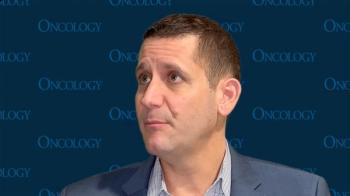
FDA Grants Approval to Pembrolizumab for the Treatment of Advanced Esophageal or GEJ Carcinoma
Based on positive overall and progression-free survival data from the phase 3 KEYNOTE-590 trial, pembrolizumab was approved by the FDA for use in patients with metastatic or locally advanced esophageal or gastroesophageal junction carcinoma.
The FDA has granted approval for pembrolizumab (Ketruda) when used in combination with platinum and fluoropyrimidine-based chemotherapy for the treatment of patients with metastatic or locally advanced esophageal or gastroesophageal junction (GEJ) carcinoma who are not eligible for resection or chemoradiation. Tumors eligible for treatment need to have an epicenter 1 to 5 cm above the GEJ.1
Data supporting the approval are from the phase 3 KEYNOTE-590 trial (NCT03189719), in which pembrolizumab plus chemotherapy demonstrated significant improvements in the dual primary end points of overall survival (OS) and progression-free survival (PFS) versus chemotherapy in patients with locally advanced unresectable or metastatic esophageal and GEJ cancer, regardless of PD-L1 expression status and tumor histology.
“Because esophageal cancer generally has poor survival rates, new first-line therapies are urgently needed for these patients,” said Peter Enzingerm, MD, Director, Center for Esophageal and Gastric Cancer, Dana-Farber/Brigham and Women’s Cancer Center, said in a press release.2 “Today’s approval of this indication for [pembrolizumab] introduces a new option, which has shown a superior survival benefit compared to FU and cisplatin alone, for newly diagnosed patients with locally advanced or metastatic esophageal or GEJ carcinoma that is not amenable to surgical resection or definitive chemoradiation, regardless of PD-L1 expression status and tumor histology.”
The multicenter, randomized, placebo-controlled trial enrolled 749 patients with metastatic or locally advanced esophageal or GEJ carcinoma who could not have surgical resection or definitive chemoradiation, with PD-L1 status by PD-L1 IHC 22C3 pharmDx kit determined in all participants.
Statistically significant improvement in median OS was observed with the experimental regimen at 12.4 months (95% CI, 10.5-14.0) versus 9.8 months (95% CI, 8.8-10.8) with chemotherapy (HR 0.73; 95% CI, 0.62-0.86; P <.0001). Similarly, median PFS also saw a significant boost with the pembrolizumab combination, at 6.3 months (95% CI, 6.2-6.9) and 5.8 months (95% CI, 5.0-6.0), respectively (HR 0.65; 95% CI, 0.55-0.76; P <.0001). The objective response rate with pembrolizumab was 45% (95% CI, 40-50) versus 29% (95% CI, 25-34) for those who received chemotherapy alone (P <.0001).
The most common adverse events noted were nausea, constipation, diarrhea, vomiting, stomatitis, fatigue/asthenia, decreased appetite, and weight loss, all occurring in more than 20% of the trial population.
Patients receiving pembrolizumab for this indication are recommended for 200 mg every 3 weeks or 400 mg every 6 weeks.
Prior to this approval,
Reference
1. FDA approves pembrolizumab for esophageal or GEJ carcinoma. FDA. March 22, 2021. Accessed March 22, 2021. https://bit.ly/3191ONi
2. FDA approves Merck’s Keytruda (pembrolizumab) Plus Platinum- and Fluoropyrimidine-Based Chemotherapy for Treatment of Certain Patients With Locally Advanced or Metastatic Esophageal or Gastroesophageal Junction (GEJ) Carcinoma. News release. Merck. March 23, 2021. Accessed March 23, 2021. https://bit.ly/3tKDWf4
Newsletter
Stay up to date on recent advances in the multidisciplinary approach to cancer.
















































































